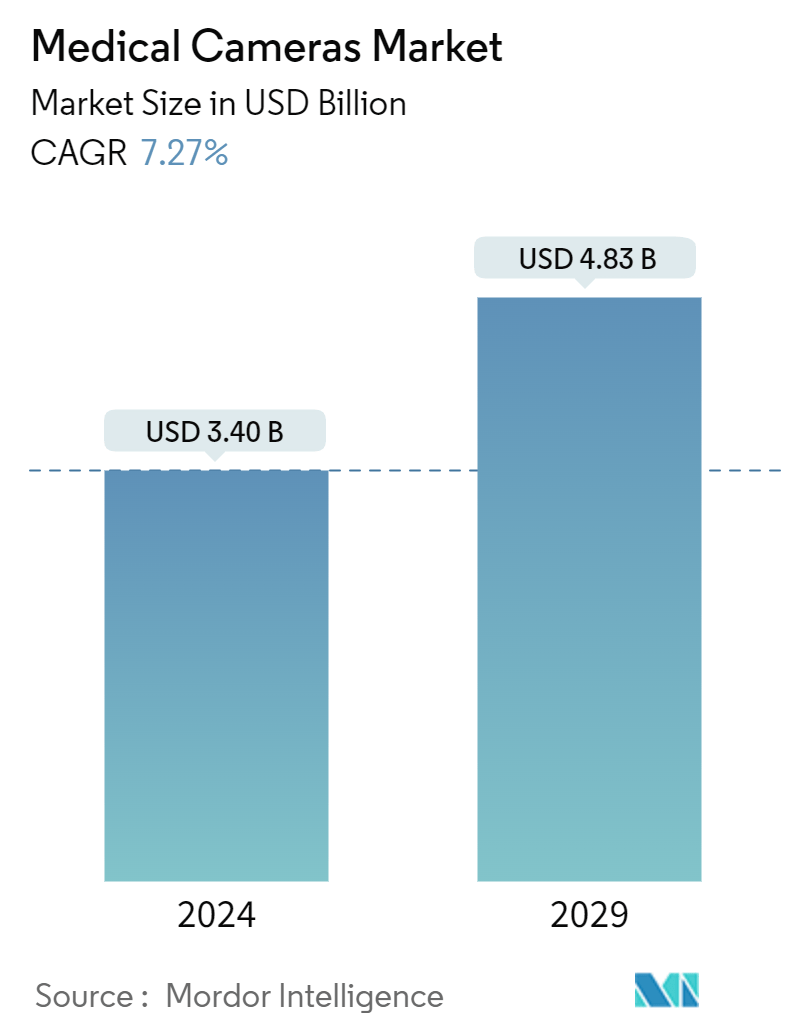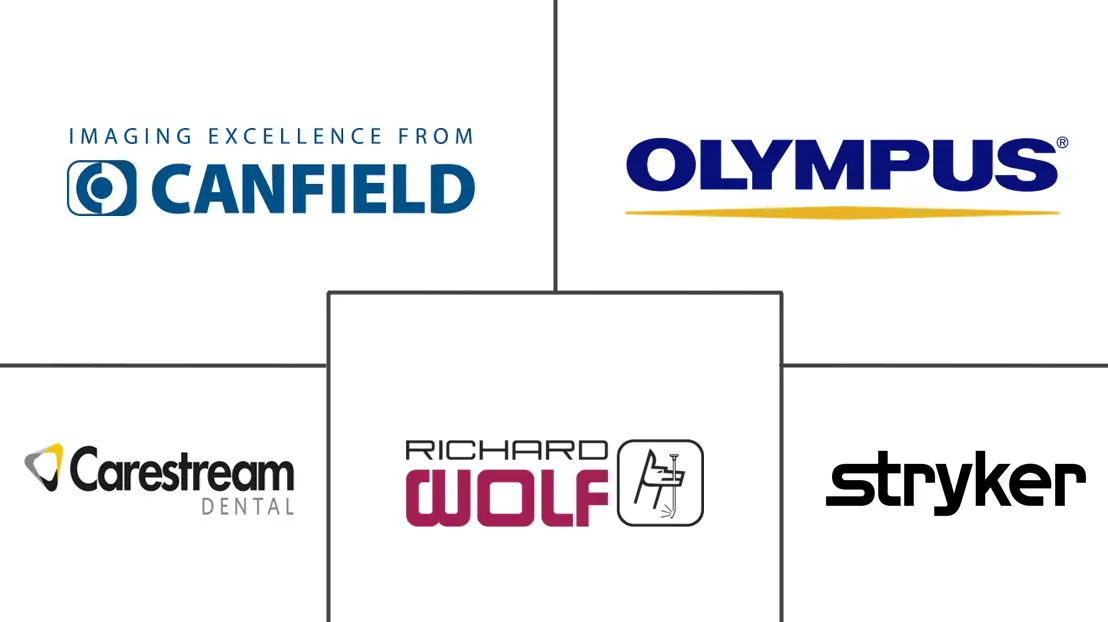Market Size of Medical Cameras Industry

| Study Period | 2019 - 2029 |
| Market Size (2024) | USD 3.40 Billion |
| Market Size (2029) | USD 4.83 Billion |
| CAGR (2024 - 2029) | 7.27 % |
| Fastest Growing Market | Europe |
| Largest Market | North America |
Major Players
*Disclaimer: Major Players sorted in no particular order |
Medical Cameras Market Analysis
The Medical Cameras Market size is estimated at USD 3.40 billion in 2024, and is expected to reach USD 4.83 billion by 2029, growing at a CAGR of 7.27% during the forecast period (2024-2029).
The COVID-19 pandemic has impacted the global healthcare system, so the medical camera system market was affected. Medical cameras are an essential part of surgical procedures, and with the significant decrease in surgical procedures, the growth of this market was impacted. The article published in the journal, Frontiers of Robot and AI in February 2021 reported that due to the COVID-19 pandemic, endoscopic procedures and other surgical procedures were significantly reduced to acute, urgent cases. Thus, initially, the growth of this market was substantially impacted; however, with a decrease in COVID-19 cases and the resumption of medical-surgical procedures, the market is expected to witness significant growth over the forecast period.
The factors driving the growth of the studied market are the rising demand for high-definition visuals in surgical procedures due to the advancements in medical cameras and the growing use of medical cameras and microscopes for surgeries. For instance, an article published in the Journal of Cheminformatics in February 2021 reported that 3D high-definition and 4K ultra-high-definition envision systems are comparable in laparoscopic cholecystectomies. These are increasingly used in surgical procedures due to high-resolution images. Thus, such technologies are driving the growth of the market.
Similarly, an article published by BrightFocus, in July 2021 reported that more than 3 million Americans are living with glaucoma, and 2.7 million people aged 40 and older are affected by its most common form, open-angle glaucoma. The above article also stated that in 2020, about 80 million people have glaucoma worldwide, which is expected to increase to over 111 million by 2040. Ocular imaging devices have been widely incorporated into clinical management after their diagnostic capabilities have been documented in many ocular diseases. Thus, a high incidence of eye-related disorders propels an increase in eye diagnostic and surgical procedures, thereby driving demand for medical cameras and microscopes for surgeries.
Also, in July 2021, Alcon demonstrated the surgical ophthalmic product portfolio at the American Society of Cataract and Refractive Surgery (ASCRS) 2021 annual meeting, including the NGENUITY 3D Visualization System. It consists of a 3D stereoscopic, high-definition digital video camera and workstation to provide magnified stereoscopic images of objects during micro-surgery. It acts as an adjunct to the surgical microscope during surgery displaying real-time images or images from recordings. Similarly, in January 2022, Zaamigo launched an innovative product, an intelligent camera that analyzes the cleanliness of teeth with artificial intelligence. Thus, such developments are driving the growth of the studied market.
Thus, the market is expected to witness significant growth over the forecast period due to the rising demand for high-definition visuals in surgical procedures, advancement in medical cameras, and the growing use of medical cameras and microscopes for surgeries. However, the high cost and requirement of substantial investment may slow the growth over the forecast period.
Medical Cameras Industry Segmentation
As per the scope of this report, medical cameras are the devices surgeons and clinical staff use to capture color images during microscopy and surgical procedures. The medical cameras market is segmented by Type (Dental Cameras, Dermatology Cameras, Endoscopy Cameras, Ophthalmology Cameras, Surgical Microscopy Cameras, and Other Cameras), Resolution (Standard-Definition Cameras and High-Definition Cameras), End-User (Hospitals, Specialty Clinics, Ambulatory Surgery Centers and Other End-Users) and Geography (North America, Europe, Asia-Pacific, Middle East, and Africa, and South America). The report also covers the estimated market sizes and trends for 17 countries across major regions globally. The report offers the value (in USD million) for the above segments.
| By Type | |
| Dental Cameras | |
| Dermatology Cameras | |
| Endoscopy Cameras | |
| Ophthalmology Cameras | |
| Surgical Microscopy Cameras | |
| Other Cameras |
| By Resolution | |
| Standard-Definition Cameras | |
| High-Definition Cameras |
| By End-User | |
| Hospitals | |
| Specialty Clinics | |
| Ambulatory Surgery Centers | |
| Other End-Users |
| Geography | ||||||||
| ||||||||
| ||||||||
| ||||||||
| ||||||||
|
Medical Cameras Market Size Summary
The medical cameras market is poised for substantial growth over the forecast period, driven by the increasing demand for high-definition visuals in surgical procedures and advancements in medical camera technology. The market experienced initial setbacks due to the COVID-19 pandemic, which led to a reduction in non-urgent surgical procedures. However, as the healthcare system recovers and surgical activities resume, the market is expected to expand significantly. The rising prevalence of eye-related disorders and the growing use of medical cameras and microscopes in surgeries further propel market growth. Innovations such as 3D high-definition and 4K ultra-high-definition systems are becoming integral in surgical procedures, enhancing the quality of visual aids and supporting complex surgeries.
The endoscopy segment, in particular, is witnessing robust growth due to the increasing number of endoscopic procedures and the rising prevalence of diseases detectable by endoscopy, such as colorectal cancer. Technological advancements and new product launches, like the MALYNA system and the ArthroFree System, are enhancing the capabilities of medical cameras, driving their adoption in various surgical settings. The North American region, characterized by a high prevalence of chronic disorders and an aging population, is a significant contributor to market growth. The presence of key market players and ongoing technological innovations in the region further bolster the market's expansion. Despite the competitive landscape, with numerous global and regional players, the market continues to evolve, offering opportunities for growth and development.
Medical Cameras Market Size - Table of Contents
-
1. MARKET DYNAMICS
-
1.1 Market Overview
-
1.2 Market Drivers
-
1.2.1 Rising Demand for High-definition Visuals in Surgical Procedures and Advancement in Medical Cameras
-
1.2.2 Growing Use of Medical Cameras and Microscopes for Surgeries
-
-
1.3 Market Restraints
-
1.3.1 High Cost and Requirement of Substantial Investment
-
-
1.4 Porter's Five Force Analysis
-
1.4.1 Threat of New Entrants
-
1.4.2 Bargaining Power of Buyers/Consumers
-
1.4.3 Bargaining Power of Suppliers
-
1.4.4 Threat of Substitute Products
-
1.4.5 Intensity of Competitive Rivalry
-
-
-
2. MARKET SEGMENTATION (Market Size by Value - USD million)
-
2.1 By Type
-
2.1.1 Dental Cameras
-
2.1.2 Dermatology Cameras
-
2.1.3 Endoscopy Cameras
-
2.1.4 Ophthalmology Cameras
-
2.1.5 Surgical Microscopy Cameras
-
2.1.6 Other Cameras
-
-
2.2 By Resolution
-
2.2.1 Standard-Definition Cameras
-
2.2.2 High-Definition Cameras
-
-
2.3 By End-User
-
2.3.1 Hospitals
-
2.3.2 Specialty Clinics
-
2.3.3 Ambulatory Surgery Centers
-
2.3.4 Other End-Users
-
-
2.4 Geography
-
2.4.1 North America
-
2.4.1.1 United States
-
2.4.1.2 Canada
-
2.4.1.3 Mexico
-
-
2.4.2 Europe
-
2.4.2.1 Germany
-
2.4.2.2 United Kingdom
-
2.4.2.3 France
-
2.4.2.4 Italy
-
2.4.2.5 Spain
-
2.4.2.6 Rest of Europe
-
-
2.4.3 Asia-Pacific
-
2.4.3.1 China
-
2.4.3.2 Japan
-
2.4.3.3 India
-
2.4.3.4 Australia
-
2.4.3.5 South Korea
-
2.4.3.6 Rest of Asia-Pacific
-
-
2.4.4 Middle East and Africa
-
2.4.4.1 GCC
-
2.4.4.2 South Africa
-
2.4.4.3 Rest of Middle East and Africa
-
-
2.4.5 South America
-
2.4.5.1 Brazil
-
2.4.5.2 Argentina
-
2.4.5.3 Rest of South America
-
-
-
Medical Cameras Market Size FAQs
How big is the Medical Cameras Market?
The Medical Cameras Market size is expected to reach USD 3.40 billion in 2024 and grow at a CAGR of 7.27% to reach USD 4.83 billion by 2029.
What is the current Medical Cameras Market size?
In 2024, the Medical Cameras Market size is expected to reach USD 3.40 billion.

